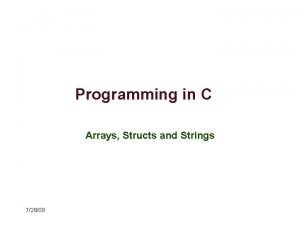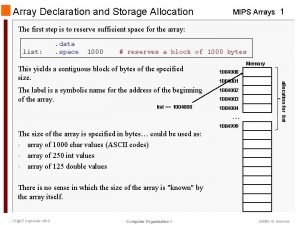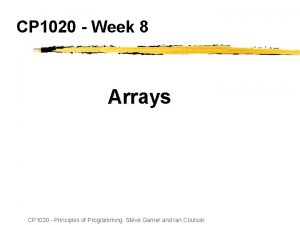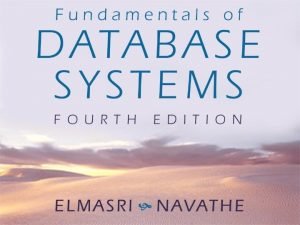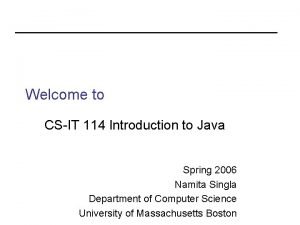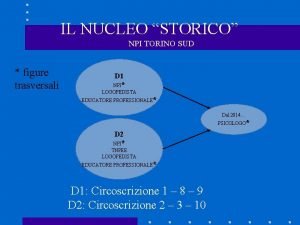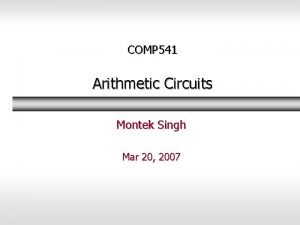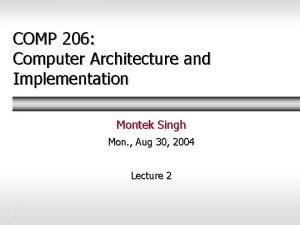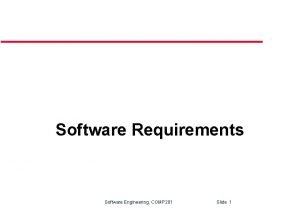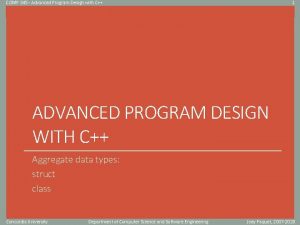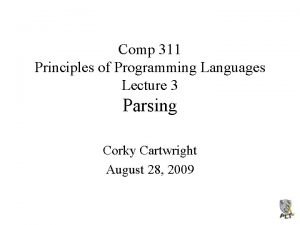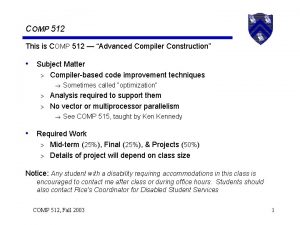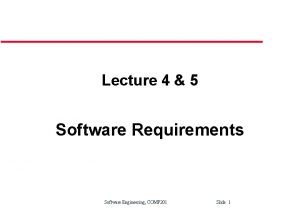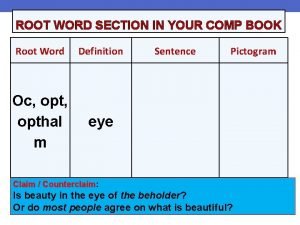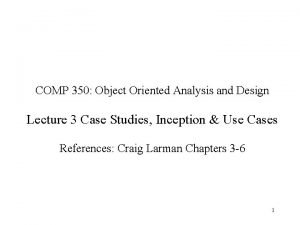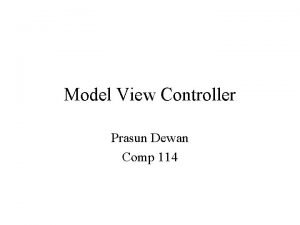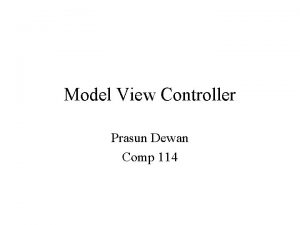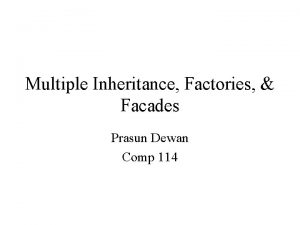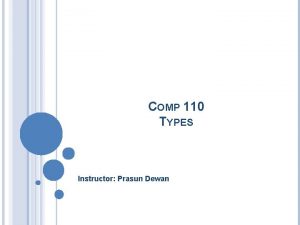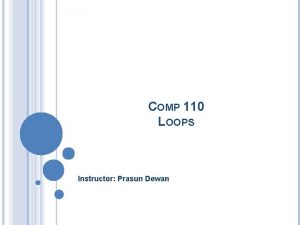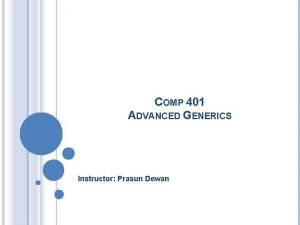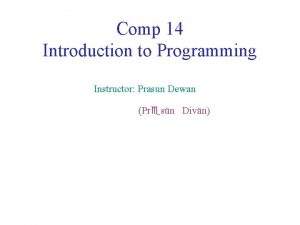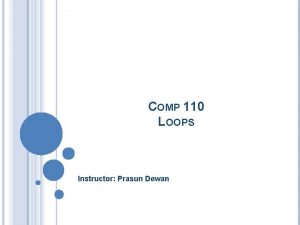Assertions Prasun Dewan Comp 114 Assertions Declare some




















































































































































- Slides: 148

Assertions Prasun Dewan Comp 114

Assertions • Declare some property of the program • Potentially useful for – specification – testing – formal correctness – documentation

Compile time vs. runtime properties • Some assertions language supported – Compile time • String s = next. Element() – Runtime • ((String) next. Element()) – Asserting type properties of object. – Assertions describe runtime properties

Application-independent vs. dependent • Language can provide us with fixed number of application-independent assertions. • Cannot handle – First character of String is a letter. – Letter concept not burnt into language. • Class Character defines it – Innumerable assertions about letters possible • Second elements of string is letter. • Third element of string is letter. • Need mechanism to express arbitrary assertions

Assertions vs. Exceptions • Wrong assertion results in exception. • Wrong class cast leads to class cast exception.

Reasons for exceptions • User error – Programmer cannot prevent it • Internal error – Programmer can prevent • Assertions catch internal errors.

Reasons for assertions • Why catch internal errors via assertions? • Alternative: Make test runs and look at output.

Finite test runs • Some errors not exhibited in test runs. – Inconsistent string not printed because of user option.

Late detection • Output produced much after the cause – Storing an inconsistent string causes erroneous output when the string is matched not when it is stored.

Complex output • May not know what the output is, but know the relationship between input and output – (123. 345 * 789. 123 ) / 123. 345 == 789. 123 – Number is divisible by a prime factor

No manifestation in output • Some errors have to do with efficiency. – Storing duplicate items in a set. • Not exhibited in output

Example Assertion { y = 10/x; z = 5} assert (y == 10/x) & (z == 5) Our own mathematical syntax to be mapped to Java later

Definition • Example { y = 10/x; z = 5} assert (y == 10/x) & (z == 5) • Statement regarding – State of program (variable values) – Program counter (currently executing statement) • PC implicit by putting assertion next to a statement – Specifies Boolean expression involving selected program variables – Assertion fails if boolean expression false – Not all program variables named • X unnamed above • Does not care about unnamed variables

Role of Assertions • Debugging – Exception thrown if assertion fails • Documentation // detailed prime factor computation code …. assert (number % prime) == 0 • Specification – Assertion defined desired result of the code to be implemented • Formal correctness – Can prove if assertion met by code. – Need assertions regarding language constructs

Recording Variables {X = X + 1} assert ? ? ? • Cannot say: {X = X + 1} assert X == X + 1; • Introduce recording variable {old. X = X; X = X + 1} assert X = old. X + 1 • Special variables needed to make assertions sometimes

Preconditions and Postconditions • Precondition assert (x !=0) { y = 10/x; z = 5} assert (y == 10/x) & (z == 5) – What is expected before statement(block) execution • Postcondition – What is guaranteed after statement(block) if precondition met • Together define a contract

Alternative syntax • Both conditions placed before statement block. pre (x !=0) post (y == 10/x) & (z == 5) { y = 10/x; z = 5}

Incorrect precondition? x = 0; pre (x !=0) post (y == 10/x) & (z == 5) { y = 10/x; z = 5} • Precondition may not be satisfied by previous incorrect statement. • Yet it is a correct precondition

Alternative precondition • Some assertions imply others – x > 0 x !=0 pre (x > 0) post (y == 10/x) & (z == 5) { y = 10/x; z = 5} • Implied assertion is considered weaker. • Can always replace precondition with a stronger one. • Prefer weakest precondition – Requires fewest assumptions. – Statement can be used in more contexts – Better documentation

Alternative postcondition • Some assertions imply others – y == 10/x & (z == 5) => z == 5 pre (x != 0) post (z == 5) { y = 10/x; z = 5} • Can always replace postcondition with a weaker one • Prefer strongest postcondition – More detailed documentation – Can be used in more contexts • Can be followed by statements with stronger preconditions.

Too strong Comp 114 • pre arrays, loops, procedures • {Take Comp 114} • post objects, inheritance, trees, recursion, assertions, composite, iterator, visitor pattern • pre arrays, loops, procedures, objects, inheritance • {Take Comp 114} • post recursion Too weak

Course Analogy • Preconditions – Declared course prerequisite • Post conditions – Advertised objectives • Stronger precondition – Does not allow some students to enroll • Weaker post conditions – Does not allow enrollment in future courses

Strongest Postcondition? • Says nothing about x. pre (x !=0) post (y == 10/x) & (z == 5) { y = 10/x; z = 5}

Strongest Postcondition • Strongest post condition given pre (x !=0) the precondition post (y == 10/x) & (z == 5) & (x != 0) • The stronger the pre condition, { y = 10/x; z = 5} stronger the post condition.

Alternative weakest/strongest pair Stronger precondition pre (x > 0) post (y == 10/x) & (z == 5) & (x > 0) & (y > 0) { y = 10/x; z = 5} Stronger postcondition

Multiple valid pairs • Weakest precondition relative to post condition. • Strongest post condition relative to pre condition. • A statement not associated with a unique pair that is best. • Strengthening the precondition strengthens the post condition • What is the “right pair? ”

Two approaches • Start with a precondition – Find the strongest postcondition we can prove. • Start with a post condition – Find the weakest precondtion for it.

Theoretical specification point of view • Specify the result needed as a post condition. • Identify the weakest precondition needed to obtain the result. • Write a program that satisfies the pair.

Reality specification point of view • Based on what you can assume you change your expectations. • Iterative process.

Debugging/specification/ documentation point of view • Precondition of a statement should be weakest one necessary for “correct” operation of program. – Correct means no exception. • A statement that is not equivalent should not have the same pre and post condition

Debugging/specification/ documentation point of view pre (x >0) post (y == 10/x) & (z == 5) & (x > 0) { y = 10/x; z = 5} pre (x >0) post (y == 10/x) & (z == 5) & (x > 0) { y = 10/x; z = 5; x = abs(x) + 1} Statements are not equivalent

Debugging/ specification/ documentation point of view Best pre and post conditions pre (x !=0) post (y == 10/x) & (z == 5) & (x != 0) { y = 10/x; z = 5}

Proving programs correct point of view • Precondition can be stronger than one that is the best one for the statement from debugging/specification/documentation point of view • Allows us to derive pre and post conditions of containing statement/program

Program correctness proof pre post (x == 1) {x = 1} pre (x == 1) post (y == 10/x) & (z == 5) & (x == 1) { y = 10/x; z = 5}

Program correctness proof pre post (y == 10/x) & (z == 5) & (x == 1) {x = 1; y = 10/x; x= 5}

Changeable assertions • What we assert about a statement (to prove program correct) may depend on what is executed before it. • Need facilities to change assertions easily. • Proxies explained later address this.

Weakest possible condition • • • Implied by anything true p true If p is true then true is true. But true is always true. So p can be any boolean expression.

Strongest possible condition • • Implies anything false p If false is true then p is true But false is never true. So any p is implied. “I will give you a million dollars when hell freezes over”

Important equivalence • P Q !P | Q • P true !P | true • false Q !false | Q true

Asserting false switch c { case ‘a’: … case ‘b’: … default: assert false } Unreachable statement

Invariant • True before and after statement pre (x !=0) post (y == 10/x) & (z == 5) & (x != 0) { y = 10/x; z = 5}

Separately declared • List invariant separately inv (x !=0) post (y == 10/x) & (z == 5) { y = 10/x; z = 5}

Invariants for debugging purposes • Should never be false – False strongest invariant of all statements. – But not best for a reachable statement as it does not convey useful information – Never assert it for reachable statements if assertion not done for program proofs. • Should never involve recording variables – recording variables describe how program variables change – invariants describe how these variables do not change

Loop Invariant sum = 0; j = 0; while (j < n) { j++; sum = sum + j; } • Holds true before and after each loop iteration, that is, before and after each execution of loop body.

Loop Invariant • Holds true before and after each loop inv (sum = 0 j k) & (j <= n ) & (j >= 0) iteration, that is, sum = 0; before and after each j = 0; execution of loop while (j < n) { body. j++; sum = sum + j; }

Method assertions invariant x != 0 post (y == 10/x) & (z == 5) & (x != 0) void m () { y = 10/x; z = 5; } • Preconditions, postconditions, invariants associated with method body

Class assertions public class C { int x =0; int y = 1; public void increment. XAnd. Y () { increment. X(); increment. Y(); } public int get. X() { return x; } public int get. Y() { return y; } increment. X() { x++; } increment. Y() { y++; } } • Preconditions, postconditions, invariants shared by all public methods of class

Class assertions inv y == x + 1 public class C { int x =0; int y = 1; public void increment. XAnd. Y () { increment. X(); increment. Y(); } public int get. X() { return x; } public int get. Y() { return y; } increment. X() { x++; } increment. Y() { y++; } } • Preconditions, postconditions, invariants shared by all public methods of class

Expressing Assertions • Natural language – All array elements are not odd. – All array elements are either odd or positive. – Easy to read but ambiguous. • Programming language – Library or language constructs – Executable, unambiguous but language-dependent and awkward • Useful for debugging • Specification cannot be done before language decided. • Mathematical language – Uambiguous, time tested, convenient but not executable

Propositional Calculus • Logic operators • not, and, or • We will use Java syntax. • Quantifiers – Universal ( ) – Existential ( ) • Propositional variables • Program • Others: Recording, Quantifier • Propositions – Boolean expressions involving operators, variables, and quantifiers • Simple/quantified propositions – Do not use/use quantifiers

Propositional Algebra • Calculus based on algebra • Algebra defines – Arithmetic operations – Relations operations – We will use Java syntax

Example Propositions • Simple propositions – – True False X>6 (X > 6 ) & (Y < 2) • Quantified – j: 0 <= j < b. size() : b. element. At(j) != null • All elements of B are not null – j: 0 <= j < b. size(): b. element. At(j) != null • At least one element of B is not null.

Quantified Propositions • Quantified – j: 0 <= j < b. size(): b. element. At(j) != null • General form: – Qx: D(x): P(x) – Q is either or quantifier – X is quantified variable – D(x) is domain description – P(x) is sub-proposition • Sub-proposition – Simple or quantified proposition in terms of quantifier • Domain – A collection of values used in sub-proposition evaluation – b. element. At(0), … b. element. At(B. size() – 1 • Domain description – Describes domain using quantified variable

Expressing Assertions in Java • Write your own code. • Libraries • Language support – Does not support quantifiers – Works for 1. 4 – You have 1. 3

Assertion Failed Exception package assertions; public class An. Assertion. Failed. Exception extends Runtime. Exception { public An. Assertion. Failed. Exception () {}; public An. Assertion. Failed. Exception (String init. Value) { super (init. Value); } } • Thrown when assertion fails • Unchecked because internal error • Can subclass it for specific assertions • Will use message in examples

Assert methods package assertions; import java. util. Enumeration; public class An. Asserter { public static void assert (boolean proposition, String message) throws An. Assertion. Failed. Exception { if (!proposition) throw new An. Assertion. Failed. Exception (message); } public static void assert (boolean proposition) throws An. Assertion. Failed. Exception { assert (proposition, “”); } • Used for simple assertions }

Using assert //inv (sum = 0 j k) & (j <= n ) & (j >= 0) sum = 0; j = 0; while (j < n) { j++; sum = sum + j; } • Must write our boolean expression that is passed to assert – public static int sum (int from, int to) { … } • Must code pre/post conditions and invariants as assert calls

Using assert sum = 0; j = 0; //inv (sum = 0 j k) & (j <= n ) & (j >= 0) while (j < n) { An. Asserter. assert (j <= n && j >= 0 && sum == sum(0, j)) j++; sum = sum + j; An. Asserter. assert (j <= n && j > =0 && sum == sum(0, j)) } • Must write our boolean expression that is passed to assert – public static int sum (int from, int to) { … } • Must code pre/post conditions and invariants as assert calls

Class and Method Invariants //inv y = x + 1 • Class invariant public class C { – Encode them as invariants of int x =0; all public methods. int y = 1; public void increment. XAnd. Y () { • Method invariant increment. X(); – Put assert at start and end of increment. Y(); public methods } public int get. X() { return x; } public int get. Y() { return y; } increment. X() { x++; } increment. Y() { y++; } }

Class and Method Invariants //inv y = x + 1 public class C { int x =0; int y = 1; void assert. Class. Invariant{ An. Asserter. assert (y == x + 1); } public void increment. XAnd. Y () { assert. Class. Invariant(); increment. X(); increment. Y(); assert. Class. Invariant(); } public int get. X() { assert. Class. Invariant(); ? ? ? return x; } … } • Class invariant – Encode them as invariants of all public methods. • Method invariant – Put assert at start and end of method Cannot put something after return and return may have side effects (return x++)

Class and Method Invariants //inv y = x + 1 public class C { int x =0; int y = 1; void assert. Class. Invariant{ An. Asserter. assert (y == x + 1); } void internal. Increment. XAnd. Y () { increment. X(); increment. Y(); } public void increment. XAnd. Y () { assert. Class. Invariant(); internal. Increment. XAnd. Y(); assert. Class. Invariant(); } internal. Get. X() { return x; } public int get. X() { assert. Class. Invariant(); int ret. Val = internal. Get. X(); assert. Class. Invariant(); return ret. Val; } • Can define another proxy method that asserts and calls the real method – Keeps asserting code separate – Useful for functions – Useful when multiple exit points Asserting proxy method

Multiple exit points char assign. Grade (int score) { if (score >= 50) { grade = ‘P’; return; } else grade = ‘F’; } char asserting. To. Grade (int score) { assign. Grade(score); assert (grade == ‘F’ || grade == ‘P’); } • Can define another proxy method that asserts and calls the real method – Keeps asserting code separate – Useful for functions – Useful when multiple exit points

Quantified Assertions • Syntax – Qx: D(x): P(x) – j: 0 <= j < b. size(): b. element. At(j) != null • Goal: – Write general boolean functions that take as arguments encoding of the elements of domain and return true iff proposition is true – Will write separate functions for universal and existential quantifer

Goal package assertions; import java. util. Enumeration; public class AQuantifier { public static boolean for. All (…) { … } public static boolean there. Exists (…) { … } } • Need to fill the …

Problem with inaccessible variables • Syntax – Qx: D(x): P(x) – j: 0 <= j < b. size(): b. element. At(j) != null • How to describe D(x) and P(x)? – Cannot pass expression string as variables involved have no meaning to library – Will pass one argument describing the domain • Collection of elements – Another argument describing the subproposition to be evaluated for each domain element.

How to describe domain? • Syntax – Qx: D(x): P(x) – j: 0 <= j < b. size(): b. element. At(j) != null • Domain can be – Array, Vector, String. History, … • Need a common interface to describe elements – java. util. Enumeration

Describing the domain package assertions; import java. util. Enumeration; public class AQuantifier { public static boolean for. All ((Enumeration domain, …) { while (domain. has. More. Elements()) … } public static boolean there. Exists ((Enumeration domain, …) { while (domain. has. More. Elements()) … } } An. Asserter. assert(AQuantifier. for. All(B. elements(), …, "Some element of B is null"); An. Asserter. assert(AQuantifier. there. Exists(b. elements(), …, "All elements of B are null"); Need to fill …

How to describe Subproposition • Syntax – Qx: D(x): P(x) – j: 0 <= j < b. size(): b. element. At(j) != null • Cannot pass expression string as variables involved have no meaning to library • But can pass function that evaluates it. – boolean is. Not. Null(Object element) { return element != null; } • Function will be evaluated for each domain element by our libraries

Subproposition as a function package assertions; import java. util. Enumeration; public class AQuantifier { public static boolean for. All (Enumeration domain, (object boolean) sub. Proposition) { while (domain. has. More. Elements()) if (!sub. Proposition (domain. next. Element()) return false; return true; } public static boolean there. Exists ((Enumeration domain, (object boolean) sub. Proposition) { while (domain. has. More. Elements()) if (!sub. Proposition (domain. next. Element()) return true; return false; } } An. Asserter. assert(AQuantifier. for. All(B. elements(), is. Not. Null), "Some element of B is null"); An. Asserter. assert(AQuantifier. there. Exists(b. elements(), is. Not. Null), "All elements of B are null");

How to describe Subproposition package assertions; public interface Element. Checker { public boolean visit (Object element); } • Cannot pass expression string. • But can pass function that evaluates it. – boolean is. Not. Null(Object element) { return element != null; } package visitors; • import assertions. Element. Checker; public class ANon. Null. Checker • implements Element. Checker { public boolean visit(Object element) { return (element != null); • } } Java does not support function parameters But allows object parameters – Object = data + functions All subproposition objects implement same interface • A subproposition object visits each element

Describing the subproposition package assertions; Call import java. util. Enumeration; public class AQuantifier { public static boolean for. All (Enumeration domain, Element. Checker sub. Proposition) { Callback while (domain. has. More. Elements()) if (!sub. Proposition. visit(domain. next. Element())) return false; return true; } public static boolean there. Exists (Enumeration domain, Element. Checker sub. Proposition) { while (domain. has. More. Elements()) if (sub. Proposition. visit(domain. next. Element())) return true; return false; } } An. Asserter. assert(AQuantifier. for. All(b. elements(), new ANon. Null. Checker()), "Some element of B is null"); An. Asserter. assert(AQuantifier. there. Exists(b. elements(), new ANon. Null. Checker()), "All elements of B are null");

Calls vs. Callbacks • Calls – calls from reusing class to reused class • Callbacks – calls from reused class to reusing class. – not to implement a symbiotic relationship – done to service calls

Subproposition accessing vars other than domain elements • • j: 0 <= j < b. size(): b. element. At(j) != a. element. At(0) package visitors; import assertions. Element. Checker; public class ANon. Null. Checker implements Element. Checker { public boolean visit(Object element) { return (element != null); } } No constructor An. Asserter. assert(AQuantifier. for. All(b. elements(), new ANon. Null. Checker()), "Some element of B is null");

Subproposition accessing vars other than domain elements • • j: 0 <= j < b. size(): b. element. At(j) != a. element. At(0) Each external var becomes constructor parameter package visitors; import assertions. Element. Checker; public class An. Inequality. Checker implements Element. Checker { Object test. Object; public An. Inequality. Checker(Object the. Test. Object) { test. Object = the. Test. Object; } public boolean visit(Object element) { return !element. equals(test. Object); } } An. Asserter. assert(AQuantifier. for. All(b. elements(), new An. Inequality. Checker(a. element. At(0))), "Some element of b is equal to a. element. At(0)");

Visitor Pattern • • Some collection C of elements of type T Visitor interface – public interface Element. Checker { public boolean visit (Object element); } – public interface V {public T 2 m (T p); } • One or more traverser methods that use collection and visitor interface to pass one or more collection elements to the method. – public static boolean for. All (Enumeration domain, Element. Checker sub. Proposition) {…sub. Proposition. visit(domain. next. Element()); – traverser 1 (C c, V v) { …v. m(element of C)…} • Implementation of interface whose constructors take as arguments external variables that need to be accessed by the visitor method public class An. Inequality. Checker implements Element. Checker { Object test. Object; public An. Inequality. Checker(Object the. Test. Object) {…} public boolean visit(Object element) {…}; } public class AV 1 implements V { public AV 1 (T 1 p 1, … Tn p. N) { …} public T 2 m (T p) { … } } • Client passes traverser visitor implementation and collection – AQuantifier. for. All(b. elements(), new An. Inequality. Checker(a. element. At(0))); – traverser 1(c, new AV 1(a 1, . . a. N));

Visitor Pattern Collection Interface C with elements of type T component element 1: T uses Traverser 1 element 1: T Traverser 2 Visitor Interface implements Visitor Class 1 Visitor Class 2

Example of Visitor Pattern Enumeration uses component Object for. All() Object there. Exists() Element. Checker implements ANon. Null Checker An. Inequality Checker

Nested Assertions j: 0 <= j < b. size(): k: 0 <= k < b. element. At(j). size(): b. element. At(j). element. At(k) != null package visitors; import assertions. Element. Checker; public class ANon. Null. Checker implements Element. Checker { public boolean visit(Object element) { return (element != null); } } package visitors; import assertions. Element. Checker; public class AFor. All. Checker implements Element. Checker { public boolean visit(Object element) { Enumeration children = ( (Vector) element). elements(); return AQuantifier. for. All(children, new ANon. Null. Checker())); Visiting Hierarchical Structures (Trees) } } An. Asserter. assert(AQuantifier. for. All(b. elements(), new AFor. All. Checker(), "Some leaf-level element of b is null”);

Example of Pattern in Everyday Applications • • • Program tree A visitor for printing all nodes. Another for type checking. Yet another for generating code Do not want to put all of this code in tree class. • In any case, printing should not be in tree.

Java 1. 4 Assertion Support • Assertion. Error exception = An. Assertion. Failed. Exception • assert <boolean expression> = An. Asserter. assert(<boolean expression>, “”); • assert <boolean expression>: <value> = An. Asserter. assert(<boolean expression>, string representation of <value> • Compile option determine if assert is keyword – javac –source 1. 4 models/ACounter. java • Assertions can be dynamically turned on or off for package or Class – java –da: bus. uigen –ea models. ACounter • No support for quantifiers.

Error vs. Exception • Java assertion failure results in Assertion. Error • Subclass of Error rather than Run. Time. Exception • Reasoning: – Convention dictates that Run. Time. Exception should be caught – Should “discourage programmers from attempting to recover from assertion failures. ” • Might do custom reporting, mail error report etc. – Decision was controversial

Modularizing assertion code • How to not clutter regular with assertion code. • How to turn off/change library-based assertion code?

Proxy Methods char assign. Grade (int score) { if (score >= 50) { grade = ‘P’; return; } else grade = ‘F’; } char asserting. To. Grade (int score) { assign. Grade(score); assert (grade == ‘F’ || grade == ‘P’); } • Can define another proxy method that asserts and calls the real method – Keeps asserting code separate – Useful for functions – Useful when multiple exit points

Proxy classes • Put assertion code in special classes that are proxies for real classes. • Factory, factory selectors and factory methods can be used to choose between proxy and regular classes.

Counter package models; public class ACounter implements Counter { int counter = 0; public void add (int amount) { counter += amount; } public int get. Value() { return counter; } }

Asserting Proxy Class package models; import assertions. An. Asserter; public class AChecked. Counter extends ACounter { public void add (int amount) { int old. Counter = counter; super. add(amount); An. Asserter. assert(counter == old. Counter + amount, "New counter: " + counter + " != old counter: " + old. Counter + " + amount: " + amount); } }

Example of Proxy Pattern ACounter implements IS-A implements AChecked Counter

Proxy Pattern Real Subject Class IS-A Proxy Class implements Subject Interface implements

Proxies in everyday apps • Proxy is a stand-in for real subject. • Adds to one or more method implementations • Web proxies – Cache data – Redirect to nearest server • Proxy may – – Log Cache (remote proxy) Provide access control Assert

Asserting Proxy Class package models; import assertions. An. Asserter; public class AChecked. Counter extends ACounter { public void add (int amount) { int old. Counter = counter; super. add(amount); An. Asserter. assert(counter == old. Counter + amount, "New counter: " + counter + " != old counter: " + old. Counter + " + amount: " + amount); } } Alternative way of doing proxy?

Delegating Proxy • Proxy HAS-A reference to the Subject and not IS-A Subject. • Proxy is called delegator and subject is called delegate

Delegating Proxy-based Counter package models; import assertions. An. Asserter; public class ADelegating. Checked. Counter implements Counter { Counter counter; public ADelegating. Checked. Counter (Counter the. Counter) { counter = the. Counter; } public void add (int amount) { int old. Val = counter. get. Value(); counter. add(amount); int new. Val = counter. get. Value(); An. Asserter. assert(new. Val == old. Val + amount, "New counter: " + new. Val + " != old counter: " + old. Val + " + amount: " + amount); } public int get. Value() { return counter. get. Value(); } }

Example of Delegating Proxy ACounter implements HAS_A AChecked Counter implements Counter

Delegating Proxy Real Subject Class HAS_A Proxy Class implements Subject Interface implements

Inheritance vs. Delegation Real Subject Class implements Subject Interface IS-A Proxy Class implements Subject Interface Real Subject Class HAS-A Proxy Class implements

OMT (Object Modeling Technique) Real Subject Class implements Subject Interface IS-A Proxy Class implements Subject Interface Real Subject Class HAS-A Proxy Class implements

Added notation of implements Real Subject Class implements Subject Interface IS-A Proxy Class implements Subject Interface Real Subject Class HAS-A Proxy Class implements

Inheritance vs. Delegation Reused Class Reused Interface Reusing Class Reusing Interface

Inheritance vs. Delegation: Instances Reused Class Reusing Class Reused Class instance Physical component Reusing Class instance

Asserting Proxy Class package models; import assertions. An. Asserter; public class AChecked. Counter extends ACounter { public void add (int amount) { int old. Counter = counter; super. add(amount); An. Asserter. assert(counter == old. Counter + amount, "New counter: " + counter + " != old counter: " + old. Counter + " + amount: " + amount); } }

Delegating Proxy-based Counter package models; import assertions. An. Asserter; public class ADelegating. Checked. Counter implements Counter { Counter counter; public ADelegating. Checked. Counter (Counter the. Counter) { counter = the. Counter; } public void add (int amount) { int old. Val = counter. get. Value(); counter. add(amount); int new. Val = counter. get. Value(); An. Asserter. assert(new. Val == old. Val + amount, "New counter: " + new. Val + " != old counter: " + old. Val + " + amount: " + amount); } public int get. Value() { return counter. get. Value()b; } }

Inheritance vs. Delegation: Init methods/Constructor Reused Class Reusing Class declares Constructor/init (…) Reused Class Reusing Class declares Constructor/init (delegate, …)

Inheritance vs. Delegation: Super calls Reused Class Reusing Class Reused Class declares Reused method m super. m() declares Method n declares Reused method m delegate. m() Reusing Class declares Method n

Asserting Proxy Class package models; import assertions. An. Asserter; public class AChecked. Counter extends ACounter { public void add (int amount) { int old. Counter = counter; super. add(amount); An. Asserter. assert(counter == old. Counter + amount, "New counter: " + counter + " != old counter: " + old. Counter + " + amount: " + amount); } }

Delegating Proxy-based Counter package models; import assertions. An. Asserter; public class ADelegating. Checked. Counter implements Counter { Counter counter; public ADelegating. Checked. Counter (Counter the. Counter) { init(the. Counter); } public void add (int amount) { int old. Val = counter. get. Value(); counter. add(amount); int new. Val = counter. get. Value(); An. Asserter. assert(new. Val == old. Val + amount, "New counter: " + new. Val + " != old counter: " + old. Val + " + amount: " + amount); } public int get. Value() { return counter. get. Value(); } }

Inheritance vs. Delegation: Reused Methods Reused Class declares Reused method m Delegation is more work! Reusing Class Reused Class declares Reused method m delegate. m() Reusing Class declares m stub

Abstract class public abstract class An. Abstract. Title. To. Course. Mapper implements Title. To. Course. Mapper { public An. Abstract. Title. To. Course. Mapper() { fill. Courses(); } abstract Regular. Course get. Regular. Course(); abstract Freshman. Seminar get. Freshman. Seminar(); void fill. Courses() { Regular. Course intro. Prog = get. Regular. Course (); Freshman. Seminar lego. Robots = get. Freshman. Seminar(); . . . } public String get. Title() { return title. To. Course. Mapper. get. Title(); }. . . }

Concrete course user public class ATitle. To. Course. Mapper extends An. Abstract. Title. To. Course. Mapper { Regular. Course get. Regular. Course() { return new ARegular. Course(); } Freshman. Seminar get. Freshman. Seminar() { return new AFreshman. Seminar(); } }

Delegate class public class ATitle. To. Course. Mapper. Delegate implements Title. To. Course. Mapper { Course. Factory delegator; public ATitle. To. Course. Mapper. Delegate(Course. Factory the. Delegator) { delegator = the. Delegator; fill. Courses(); } void fill. Courses() { Regular. Course intro. Prog = delegator. get. Regular. Course (); Freshman. Seminar lego. Robots = delegator. get. Freshman. Seminar(); . . . } public String get. Title() { return title. To. Course. Mapper. get. Title(); }. . . }

Concrete course user public class ATitle. To. Course. Mapper. Delegator implements Title. To. Course. Mapper, Course. Factory { public Regular. Course get. Regular. Course() { return new ARegular. Course(); } public Freshman. Seminar get. Freshman. Seminar() { return new AFreshman. Seminar(); } public String get. Title() { return title. To. Course. Mapper. get. Title(); }. . . }

Inheritance vs. Delegation: Callbacks declares Reused Class Reusing Class declares Reused method m Abstract or Overridden Method n this. n() Method n Reused method m delegator. n() Method n with possibly more access

Calls vs. Callbacks • Calls – calls from reusing class to reused class • Callbacks – calls from reused class to reusing class. – not to implement a symbiotic relationship – done to service calls

Inheritance vs. Delegation: Constructors/Init methods for callbacks Reused Class declares Constructor/init (…) Reusing Class Reused Class Reusing Class declares Constructor/init (delegator, …)

Access problems • Occur with callbacks. • And if reusing class accesses variables of reused class

Inheriting String Database package collections; public class AString. Database extends AString. History implements String. Database { public void delete. Element (String element) { shift. Up(index. Of(element)); } public int index. Of (String element) { int index = 0; while ((index < size) && !element. equals(contents[index])) index++; return index; } void shift. Up (int start. Index) { int index = start. Index ; while (index + 1 < size) { contents[index] = contents[index + 1]; index++; } size--; } public boolean member(String element) { return index. Of (element) < size; } public void clear() { size = 0; }

Delegating String Set Class as type package collections; import enums. String. Enumeration; and accessing public class ADelegating. String. Database implements String. Database { non public AString. History string. History = new AString. History(); public void delete. Element (String element) { variables in shift. Up(index. Of(element)); same package } public int index. Of (String element) { int index = 0; while ((index < string. History. size) && Instantiating !element. equals(string. History. contents[index])) delegate rather than index++; return index; getting reference } from constructor. init void shift. Up (int start. Index) { int index = start. Index ; method while (index + 1 < string. History. size) { string. History. contents[index] = string. History. contents[index + 1]; index++; } string. History. size--; }

Delegating String Set public boolean member(String element) { return index. Of (element) < string. History. size; } public void clear() { string. History. size = 0; } public int size() { return string. History. size(); } public String element. At (int index) { return string. History. element. At(index); } public String. Enumeration elements() { return string. History. elements(); } public void add. Element(String element) { string. History. add. Element(element); } } Large number of forwarding stubs

Access issues • Callbacks methods – must be given public access if interface types the delegator. – can be given protected or default access – but requires class types, delegator and delegator class in same package • May need to give access to reused class variables also – through public methods – or putting delegate and delegator in same package, giving them protected/default access and using class as type

Cons of Delegation • Need to instantiate multiple classes. • Need to compose instances. • Need to define stub methods • Access problems

Pros of Delegation Reused Class Reused Interface Reusing Class Reusing Interface

Substituting Reused Class 2 Reused Interface Reusing Class 2 Reusing Interface Reused Class 2 Reused Interface Reusing Class Reusing Interface

Substituting Reused Class • Another implementation of reused interface – in inheritance requires another implementation of reusing class that duplicates methods of original reusing class. – In delegation simply requires a different object to be passed to constructor

New Inheriting Proxy Class package models; import assertions. An. Asserter; public class AChecked. Counter 2 extends ACounter 2 { public void add (int amount) { int old. Counter = counter; super. add(amount); An. Asserter. assert(counter == old. Counter + amount, "New counter: " + counter + " != old counter: " + old. Counter + " + amount: " + amount); } }

Orginal Delegating Proxy package models; import assertions. An. Asserter; public class ADelegating. Checked. Counter implements Counter { Counter counter; public ADelegating. Checked. Counter (Counter the. Counter) { counter = the. Counter; } public void add (int amount) { int old. Val = counter. get. Value(); counter. add(amount); int new. Val = counter. get. Value(); An. Asserter. assert(new. Val == old. Val + amount, "New counter: " + new. Val + " != old counter: " + old. Val + " + amount: " + amount); } public int get. Value() { return counter. get. Value(); } }

Multiple Reusing Classes • Inheritance Reused Class Reusing Class 1 Reusing Class 2 – each possible combination of reusing classes bound at compile time – Duplicates code • Delegation – can be changed dynamically

Delegation-based MVC AChecked. Counter ACounter. Console View ACounter. Controller ACounter. JOption View AConsole. Controller. And. View. And. JOption. View

Inheritance-based MVC ACounter. With. Console. View ACounter. With. Console. And. JOption. View. And. Controller No facades or notification needed

Controller with Console View package views; import models. ACounter; public class ACounter. With. Console. View extends ACounter { void append. To. Console(int counter. Value) { System. out. println("Counter: " + counter. Value); } public void add (int amount) { super. add(amount); append. To. Console(get. Value()); } }

Controller with Console and JOption View package views; import models. ACounter; import javax. swing. JOption. Pane; public class ACounter. With. Console. And. JOption. View extends ACounter. With. Console. View { void display. Message(int counter. Value) { JOption. Pane. show. Message. Dialog(null, "Counter: " + counter. Value); } public void add (int amount) { super. add(amount); display. Message(get. Value()); } }

Controller with Console and JOption View and Controller package controllers; import views. ACounter. With. Console. And. JOption. View; import java. io. IOException; public class ACounter. With. Console. And. JOption. View. And. Controller extends ACounter. With. Console. And. JOption. View implements Counter. With. Console. View. And. Controller { public void process. Input() { while (true) { int next. Input = Console. read. Int(); if (next. Input == 0) return; add(next. Input); } } }

Alternative: Delegation-based Configuration An. Observable Counter ACounter. Console View ACounter. Controller AConsole. Controller. And. View ACounter. JOption View

Alternative: Inheritance-based MVC ACounter. With. Console. View. And. Controller New class

Controller with Console and View and Controller package controllers; import views. ACounter. With. Console. And. JOption. View; import java. io. IOException; public class ACounter. With. Console. View. And. Controller extends ACounter. With. Console. View implements Counter. With. Console. View. And. Controller { public void process. Input() { while (true) { int next. Input = Console. read. Int(); if (next. Input == 0) return; add(next. Input); } Only difference between } it and previous inheriting } controller

Inheritance vs. Delegation: Distribution Data and methods of both classes at one location Reused Class Reusing Class instance Reused Class instance Reusing Class instance Can be in two different locations (client/server)

Reusing multiple classes Reused Class 1 Reused Class 2 Reusing Class Reused Class 1 Reusing Class • In Java reusing multiple classes through inheritance not an option. • Can always have multiple instance variables

Pros and Cons of Delegation • Can change reused class without changing reusing class. • Multiple reusing classes can share reused class variables simultaneously. • Variables and methods of reusing and reused class can be on separate computers. • Works in single inheritance languages • Need to instantiate multiple classes. • Need to compose instances. • Need to define stub methods • Access problems Need to weigh pros and cons When benefits of delegation don’t apply use inheritance That is why inheritance exists.

Inheritance is a bad idea • If reusing class has “with” in its name: – ACounter. With. Console. View • If more than one way to do inheritance – Controller can be subclass of view – Or vice versa • If some of the inherited methods are not used: – AString. History extends Vector • Adds methods to add and access string elements rather than object elements • add. String(), string. At() – does not use remove. Element() etc • If reusing class should not be used wherever shared class is used – even if all methods are reused.

Inheritance is a bad idea public ACartesian. Point implements Point { int x, y; public APoint(int the. X, int the. Y) { x = the. X; y = the. Y; } public int get. X() { return x } public int get. Y() { return y } public double get. Radius() { return Math. sqrt(x*x + y*y); }. public double get. Angle() { return Math. atan(y/x); } } public ASquare implements Square { Point center; int side. Length; public ASquare( Point the. Center, int the. Side. Length) { center = the. Center; side. Length = the. Side. Length; } public int get. X() {return center. get. X(); } public int get. Y() {return center. get. Y(); } public int get. Radius() {return center. get. Radius(); } public int get. Angle() {return center. get. Angle(); } public int get. Side. Length() {return side. Length; } } public ASquare extends ACartesian. Point implements Square { int side. Length; public ASquare (int the. X, int the. Y, int the. Side. Length) { x = the. X; y = the. Y; side. Length = the. Side. Length} public int get. Side. Length() {return side. Length}; } ASquare IS-NOTA ACartesian. Point!

Inheritance vs. Delegation in Popular Software: Toolkits Widget Class declares Action Performed super call Widget User Widget Class declares Action Performed delegate call Widget User declares Java 1. 0 Later versions Action Performed

Inheritance vs. Delegation in Popular Software • Main problem with inheritance based widgets – Widget users could not be subclass of any other class because of multiple inheritance • Multiple objects can receive events from same widget. • Widget implementation can be switched • Observer concept supports both approaches – Inherited Observer class vs. Delegated Property. Change. Support • Threads support both approaches – Inheritable Thread class vs. Implemented Runnable Interface

The Importance of Being Earnest public class ABank. Account implements Bank. Account { int current. Balance = 0; public static final int MIN_BALANCE = 100; public ABank. Account (int initial. Balance) { current. Balance = initial. Balance; } public void deposit (int amount) { current. Balance += amount; } public boolean withdraw (int amount) { int min. Necessary. Balance = MIN_BALANCE + amount; if (min. Necessary. Balance <= current. Balance) { current. Balance -= amount; return true; } else return false; } public int get. Current. Balance () { return current. Balance; } public boolean safe. Withdraw (int amount) { An. Asserter. assert(amount > 0, "amount < 0"); boolean ret. Val = withdraw(amount); An. Asserter. assert(current. Balance >= MIN_BALANCE, "current. Balance < MIN_BALANCE"); return ret. Val;

Usage

Usage

Usage Integer. MAX_INT

Usage

Usage

Safe Usage

Integer Overflow and Security • Google for “integer overflow security”
 Prasun dewan
Prasun dewan Prasun dewan
Prasun dewan ( 0 0 299 587 114 ) | ( 0 0 299 587 )
( 0 0 299 587 114 ) | ( 0 0 299 587 ) Nothing but my genius
Nothing but my genius Pricechar
Pricechar Exec sql begin declare section
Exec sql begin declare section I have nothing to declare but my genius
I have nothing to declare but my genius Strings in c
Strings in c Exec sql begin declare section
Exec sql begin declare section Declare an array alpha of 15 elements of type int
Declare an array alpha of 15 elements of type int Mips declare array
Mips declare array Declare plsql
Declare plsql Declare deptrec is record
Declare deptrec is record What did the vietminh declare as its goal
What did the vietminh declare as its goal Declare a two dimensional array of strings named chessboard
Declare a two dimensional array of strings named chessboard What did the vietminh declare as its main goal?
What did the vietminh declare as its main goal? Information processing objectives cavr
Information processing objectives cavr Triggers and assertions
Triggers and assertions Substantive analytical procedures
Substantive analytical procedures Sample internal audit engagement plan
Sample internal audit engagement plan General audit procedures
General audit procedures Psl assertions examples
Psl assertions examples Sql assertions
Sql assertions Audit assertions
Audit assertions Management assertions definition
Management assertions definition What are the 7 audit assertions
What are the 7 audit assertions Audit assertions
Audit assertions Hkr 112 uitm
Hkr 112 uitm Crm 114 discriminator
Crm 114 discriminator Aiaa s-114
Aiaa s-114 Csit 114
Csit 114 Taskj-114
Taskj-114 Solicitud de licencia articulo 114 y 115 decreto 688/93
Solicitud de licencia articulo 114 y 115 decreto 688/93 Npi torino
Npi torino Oesd 114
Oesd 114 Sas114
Sas114 Who wrote psalm 114
Who wrote psalm 114 Składa się z 114 sur
Składa się z 114 sur Fact act
Fact act Via lucis estaciones imagenes
Via lucis estaciones imagenes Po odparowaniu wody ze 114 g roztworu nasyconego
Po odparowaniu wody ze 114 g roztworu nasyconego Eosc 111
Eosc 111 Decreto 114/2011
Decreto 114/2011 Ppt114
Ppt114 Some may trust in horses
Some may trust in horses What is contact force
What is contact force Sometimes you win some sometimes you lose some
Sometimes you win some sometimes you lose some Fire and ice diamante poem
Fire and ice diamante poem They say it only takes a little faith to move a mountain
They say it only takes a little faith to move a mountain Some say the world will end in fire some say in ice
Some say the world will end in fire some say in ice Ice cream countable
Ice cream countable Maksud plagiat kamus dewan
Maksud plagiat kamus dewan Pada dewan ambalan ketuanya disebut
Pada dewan ambalan ketuanya disebut Majlis perbandaran seberang jaya
Majlis perbandaran seberang jaya Perbedaan dewan pendidikan dan komite sekolah
Perbedaan dewan pendidikan dan komite sekolah Tugas dewan sekolah
Tugas dewan sekolah Dewan perwakilan rakyat republik indonesia
Dewan perwakilan rakyat republik indonesia Dewan tanvir ahmed
Dewan tanvir ahmed Ppdk pramuka
Ppdk pramuka Doa masuk dewan peperiksaan
Doa masuk dewan peperiksaan The tiger king character sketch
The tiger king character sketch Sistem pentadbiran negara ptm
Sistem pentadbiran negara ptm Maksud fitrah dari segi bahasa dan istilah
Maksud fitrah dari segi bahasa dan istilah Dewan kehormatan pusat ikatan notaris indonesia
Dewan kehormatan pusat ikatan notaris indonesia Dewan jps perlis
Dewan jps perlis Pembaharuan kerajaan abbasiyah dalam bidang ketenteraan
Pembaharuan kerajaan abbasiyah dalam bidang ketenteraan Rumah selangorku jenis e
Rumah selangorku jenis e Cse buet
Cse buet Athens sejarah tingkatan 1
Athens sejarah tingkatan 1 Dewan bahasa dan pustaka cawangan sarawak
Dewan bahasa dan pustaka cawangan sarawak Kata penguat bebas
Kata penguat bebas Hukum go- food dewan fatwa al- irsyad
Hukum go- food dewan fatwa al- irsyad Dewan tanvir ahmed
Dewan tanvir ahmed Dewan taklimat serdang
Dewan taklimat serdang Perwujudan dalam kamus dewan
Perwujudan dalam kamus dewan Definisi kecederaan sukan
Definisi kecederaan sukan Dewan satuan pandu berfungsi untuk
Dewan satuan pandu berfungsi untuk Selambut
Selambut Karakteristik dewan pengawas blu
Karakteristik dewan pengawas blu Isi aaoifi dan psak syariah
Isi aaoifi dan psak syariah Minterm
Minterm Comp 252
Comp 252 Comp 541
Comp 541 Comp 553
Comp 553 Comp 523 unc
Comp 523 unc Dairy comp 305 tutorial
Dairy comp 305 tutorial Vector 4211
Vector 4211 Comp 211
Comp 211 Comp 755
Comp 755 Comp 4620
Comp 4620 Xiao team comp
Xiao team comp Comp 382
Comp 382 Comp.os.minix
Comp.os.minix Comp 335
Comp 335 Comp 112
Comp 112 Comp 755
Comp 755 General machine structure in system programming
General machine structure in system programming Doterra income disclosure
Doterra income disclosure Soren comp
Soren comp Comp 2121
Comp 2121 Comp sci 301 uw madison
Comp sci 301 uw madison Comp 5331
Comp 5331 Common case fast
Common case fast Comp 411
Comp 411 User requirements software engineering
User requirements software engineering Comp 103
Comp 103 Comp 482
Comp 482 Comp
Comp Comp 345
Comp 345 Comp 311 textbook notes
Comp 311 textbook notes Comp 3000
Comp 3000 Comp 301
Comp 301 Comp sci 1102
Comp sci 1102 Comp 401
Comp 401 Comp4332
Comp4332 Comp 482
Comp 482 Comp 249
Comp 249 Hotel comp set
Hotel comp set Comp 561
Comp 561 Robozzle solution
Robozzle solution Comp 482
Comp 482 Hebburn comprehensive school uniform
Hebburn comprehensive school uniform Comp 248 midterm
Comp 248 midterm Comp sci 1027
Comp sci 1027 Comp 550
Comp 550 Ubio quality life
Ubio quality life Unc comp 541
Unc comp 541 Comp
Comp Comp 345
Comp 345 Ubi comp
Ubi comp Comp 211
Comp 211 Comp 206
Comp 206 Comp 512
Comp 512 Comp 512
Comp 512 Istituto comprensivo aldo moro sutri
Istituto comprensivo aldo moro sutri Comp3000
Comp3000 Comp3311
Comp3311 Domain requirements
Domain requirements Root word opt
Root word opt Kidbiz 300
Kidbiz 300 Comp 350
Comp 350 Comp 361
Comp 361 Comp 354
Comp 354 Comp tox
Comp tox Comp4900
Comp4900 Comp541
Comp541 Comp 5331
Comp 5331 Be-comp diagram
Be-comp diagram Comp 206
Comp 206







